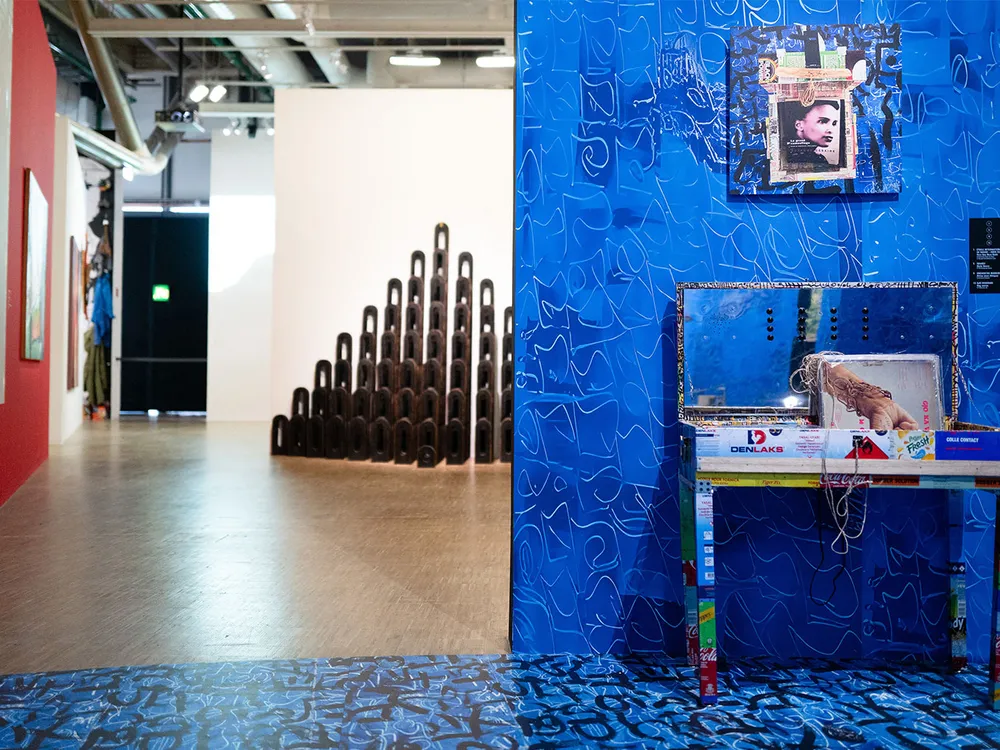This Exhibition Spotlights the Black Artists Who Called France Home in the 20th Century
This Exhibition Spotlights the Black Artists Who Called France Home in the 20th Century
A blockbuster show at the Centre Pompidou in Paris spotlights 300-plus works by 150 artists of African heritage
View of the "Paris Noir" exhibition at the Centre Pompidou in Paris
Stéphane Mouchmouche / Hans Lucas / AFP via Getty Images
An exhibition in Paris is celebrating the work of Black artists who were active in France in the second half of the 20th century. Now on view at the Centre Pompidou, which houses Europe’s largest collection of modern and contemporary art, “Paris Noir,” or “Black Paris,” features more than 300 works by 150 artists of African heritage.
“It is a story that hasn’t been told and should be,” curator Alicia Knock tells the Guardian’s Kim Willsher. “The exhibition allows us to see the richness of these artists who came to Paris, many of whom were also philosophers and poets and whose works have not been seen before in France.”
In a statement, the Pompidou describes Paris as a “place of resistance and creation that gave rise to a wide variety of practices,” including awareness of identity and a language of art that spanned cultures. In the time period covered by the exhibition, many Black Americans immigrated to France to escape racism in the United States.
Missouri-born singer Josephine Baker immigrated to Paris in 1925 and became a beloved entertainer there. In 1948, writer James Baldwin arrived in Paris and fell in love with the city, where he wrote much of his first novel. In 1949, trumpeter Miles Davis traveled to Paris to play in a quintet; as he later wrote, “It changed the way I looked at things forever. … Paris was where I understood that all white people weren’t the same, that some weren’t prejudiced and others were.”The Pompidou’s “unprecedented” exhibition highlights paintings and sculptures made by an international group of Black artists, associate curator Éva Barois De Caevel tells the Associated Press’ Sylvie Corbet. She adds that many of the works are united in their exploration of “Black consciousness,” reflecting on how racism and the legacy of slavery have shaped Black identity.
Some of the featured artists “are African Americans, some are Caribbeans, some are Africans and some are Afro-descendants,” Barois De Caevel says. “Many enjoyed being free in the streets of Paris—being able to go out with white women, enter cafes, bars and restaurants, and be treated like white people.”
Though Black Americans faced less discrimination in Paris, Africans and Algerians were “really extremely mistreated”—a trend recorded by Baldwin, Barois De Caevel says. “So it’s an ambivalent relationship with Paris.”
Many of the exhibited artists received their educations in the City of Lights. Christian Lattier of the Ivory Coast, whose 1957 sculpture Le Christ is on display, studied art at the Paris Beaux-Arts in the 1940s. Haitian painter Roland Dorcely immigrated in 1946 to study with Fernand Léger and André Masson. According to the exhibition’s audio guide, Dorcely once attempted to show his paintings at several Paris art galleries, but the majority of dealers refused to even look at his canvases.
“They expected a guy in a loincloth, with a bow and arrow,” Dorcely recalled, “not an admirer of Winslow Homer and [Georges] Seurat.”
Paris Noir: Pompidou's landmark exhibition spotlights decades of Black art and resistance
Watch on
“Paris Noir” spans many artistic movements and pivotal events in worldwide Black history, including African countries’ struggles for independence from colonial powers, apartheid in South Africa, and protests against racism in the U.S. and France. As the Guardian’s Jason Okundaye reports, the exhibition includes paraphernalia from Présence Africaine, a Pan-African cultural magazine founded in 1947 by Senegalese politician and publisher Alioune Diop, who organized the first Congress of Black Writers and Artists in Paris in 1956.
Paris was a “lab for Pan-Africanism,” the movement that suggests people of African descent share common interests and should band together, as well as an “anticolonial workshop,” Knock tells the AP. The city’s Black artists were rewriting and reframing movements like Modernism, Postmodernism and Surrealism, she says. “Many of these artists were not only creators, but also cultural ambassadors, teachers, poets and philosophers.”
Knock hopes that “Paris Noir” will be the first of many exhibitions and projects dedicated to these artists, who came to Paris and found a place where they could express themselves. Some of Paris’ African American residents had actually wanted to immigrate to their ancestral continent, using Paris as a point of transit, the museum statement notes. But as Knock tells the AP, some of the artists’ families “told us that, in fact, they had come to Paris to go to Africa, and in the end, they found Africa in Paris.”
“Paris Noir” is on view at the Centre Pompidou in Paris through June 30.
Get the latest stories in your inbox every weekday.


